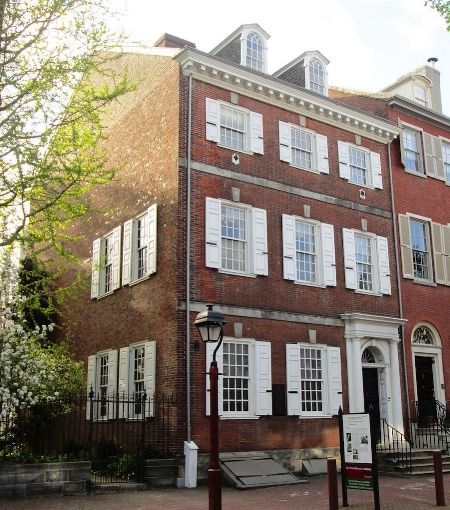Although both Eliza and Alexander Hamilton considered themselves New Yorkers, they spent much of their married life living outside their favorite colony/state and in the city of Philadelphia. Alexander's responsibilities to the new country's government - first as a member of the Congress of Confederation, and then as the first Secretary of the Treasury - took him to the country's second capitol, Philadelphia; the city had replaced New York City as the temporary capitol until Washington, DC was built and made livable.
Eliza and their ever-growing family of children soon joined Alexander in Philadelphia, living in a succession of rented lodgings and houses. In 1790, Philadelphia had a population of around 28,000, making it second only to New York as the largest American city. Yet to one of us stepping back in time, the 18thc. city would feel remarkably small and compact. Like most colonial cities dependent on international trade, Philadelphia had grown up around the docks and warehouses on the Delaware River, and gradually spread west toward the Schuylkill River.
The Hamiltons always lived within walking distance of the State House (now known as Independence Hall, where Alexander attended both the Second Continental Congress and the Constitutional Convention), the President's residence, the offices of the Department of the Treasury (which Alexander established, and oversaw as secretary), and later, the First Bank of the United States (which was founded as part of Alexander's federal banking system). For Eliza, markets, shops, church, and the homes of friends and acquaintances were also conveniently nearby.
Among those acquaintances were Samuel and Elizabeth Powel. The Powels were among the city's most affluent (Samuel had inherited nearly a hundred properties in Philadelphia) and influential citizens. Samuel had served as Philadelphia's mayor both before and after the Revolution, and later he was a member of the Pennsylvania State Senate. The Powels were good friends with George and Martha Washington, who were for a time their next-door neighbors. The Powels lived in one of the most opulent townhouses in the city, and were known for their hospitality and the lavishness of their entertainments. Among their guests were the Washingtons, Dr. Benjamin Rush, Benjamin Franklin, John Adams, and the Marquis de Lafayette.
While there's no surviving proof (like letters or invitations) that Eliza and Alexander were included in this illustrious group, it's easy to believe that they were most welcome at the Powel house. The group of friends and supporters around President Washington was a close-knit one, and both the Powels and the Hamiltons were staunch members of the Federalist party. In addition, Elizabeth Powel's brother, merchant Thomas Willing, was the first president of the First National Bank of the United States - the bank that Alexander had helped to found.
Today the Powel House is maintained by the Philadelphia Society for the Preservation of Landmarks, and is open to the public for tours. (It's only a short walk from the new Museum of the American Revolution.) The most glorious room of the house is the second-floor ballroom, with swirls of rococo plasterwork, multiple looking-glasses, and a crystal chandelier.
Standing in the middle of this lovely space myself, I had no trouble imagining Eliza and Alexander attending one of Mrs. Powel's famous balls. In the early 1790s, Alexander would have been at the height of his political power and achievement. With both of them dressed in bright silk - the Hamiltons were known as a stylish young couple - and dancing beneath that glittering chandelier, Eliza would be a little flushed, proud to be on the arm of the handsomest gentleman in the company, while Alexander would be smiling down at her, equally proud to have her as his wife.
Read more about Eliza Schuyler and Alexander Hamilton in my historical novel, I, Eliza Hamilton. My latest historical novel, The Secret Wife of Aaron Burr, is now available everywhere. Order here.


